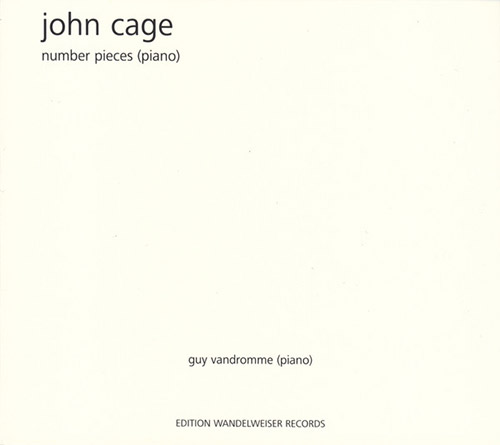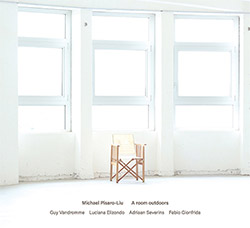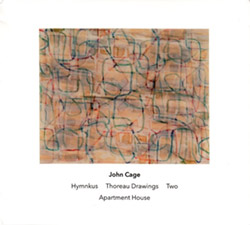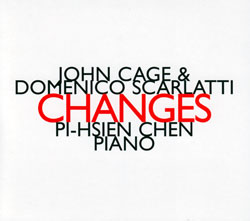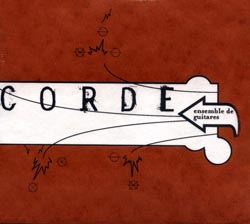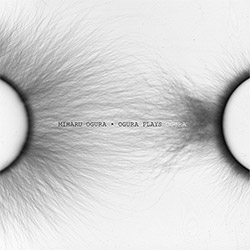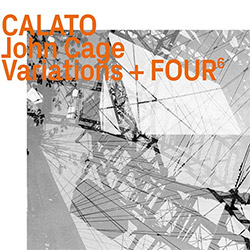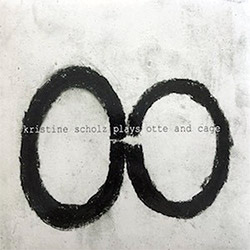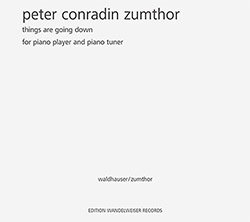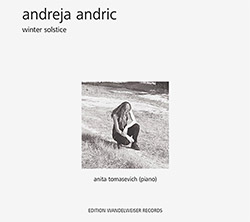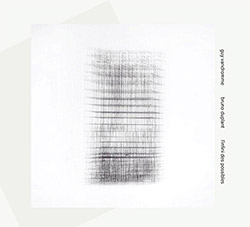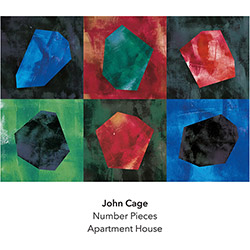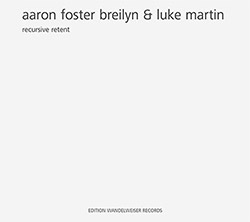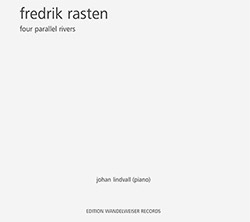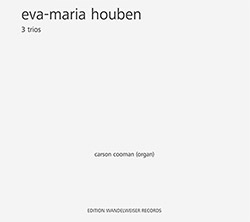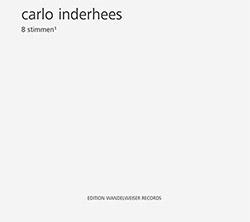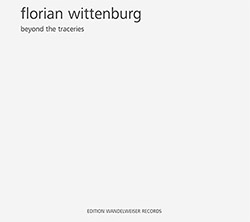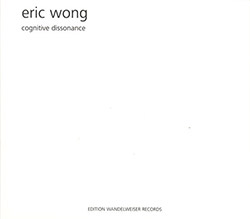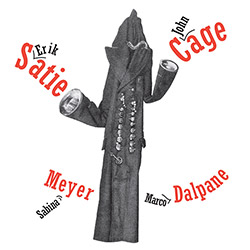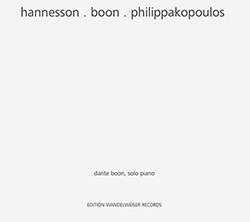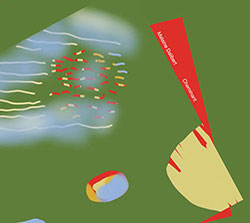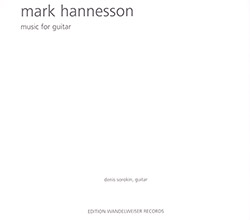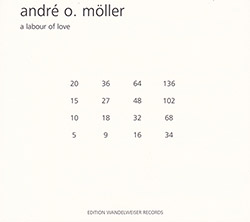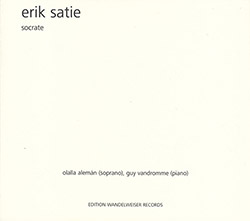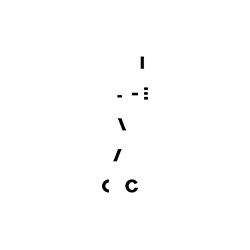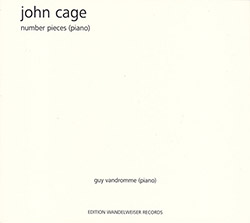
John Cage wrote his "Number Pieces" in the last years of his life, using his time bracket technique of short fragments allowing the performer flexibility in interpretation; each piece is titled for the number of performers and its ordinal position in the series, and most pieces are dedicated to a musician; here pianist Guy Vandromme performs three of the "One", or solo, series.
In Stock
Quantity in Basket: None
Log In to use our Wish List
Shipping Weight: 2.00 units
Sample The Album:
John Cage-composer
Guy Vandromme-piano
Click an artist name above to see in-stock items for that artist.
UPC: 4011778041030
Label: Edition Wandelweiser Records
Catalog ID: EWR 1807
Squidco Product Code: 26747
Format: CD
Condition: New
Released: 2018
Country: Germany
Packaging: Cardstock 3 page foldover in vinyl sleeve
Recorded at deSingel, in Antwerpen, Belgium,in November, 2013, by Wannes Gonnissen.
"The term Number Pieces refers to a body of late compositions (40, or 41 if Seventeen was actually composed) by John Cage. Each piece is named after the number of performers involved: for instance, Seven is a piece for seven performers, One9 (read "One Nine") is the ninth work for one performer, and 1O1 is a piece for an orchestra of 101 musicians. The vast majority of these works were composed using Cage's time bracket technique: the score consists of short fragments (frequently just one note, with or without dynamics) and indications, in minutes and seconds, of when the fragment should start and when it should end. Time brackets can be fixed (e.g. from 1.15 to 2.00) or flexible (e.g. from anywhere between 1.15 and 1.45, and to anywhere between 2.00 and 2.30).
All of the Number Pieces were composed during the last six years of Cage's life, 1987-1992. Most are for traditional instruments, with six exceptions that range from works for rainsticks, the Japanese aerophone shō and conch shells to an electronically amplified version of 4′33″."-Wikipedia
"One" for piano. Composed December 1987. Dedicated to Juan Allende-Blin. 10 time brackets, all flexible except for the ninth. Each contains music written on two staves, but the content of one staff can be played in any relation with that of the other staff.
"One2" for 1-4 pianos. Composed Summer 1989. Dedicated to Margaret Leng Tan. The pianist moves between several pianos (in 1992 Cage advised Margaret Leng Tan to use the I Ching to coordinate her movements). All instruments have their damper pedals wedged, so that the strings vibrate freely throughout the piece.
"One5" for piano. Composed May 1990. Dedicated to Ellsworth Snyder. 21 time brackets for the left hand and 24 for the right. Each contains a single chord or a single note. The performer is instructed to either hold the pedal throughout, or make as many overlappings as possible (again, using the pedal if necessary).

The Squid's Ear!
Artist Biographies
• Show Bio for John Cage "John Milton Cage Jr. (September 5, 1912 - August 12, 1992) was an American composer, music theorist, writer, philosopher, and artist. A pioneer of indeterminacy in music, electroacoustic music, and non-standard use of musical instruments, Cage was one of the leading figures of the post-war avant-garde. Critics have lauded him as one of the most influential American composers of the 20th century. He was also instrumental in the development of modern dance, mostly through his association with choreographer Merce Cunningham, who was also Cage's romantic partner for most of their lives. Cage is perhaps best known for his 1952 composition 4′33″, which is performed in the absence of deliberate sound; musicians who present the work do nothing aside from being present for the duration specified by the title. The content of the composition is not "four minutes and 33 seconds of silence," as is often assumed, but rather the sounds of the environment heard by the audience during performance. The work's challenge to assumed definitions about musicianship and musical experience made it a popular and controversial topic both in musicology and the broader aesthetics of art and performance. Cage was also a pioneer of the prepared piano (a piano with its sound altered by objects placed between or on its strings or hammers), for which he wrote numerous dance-related works and a few concert pieces. The best known of these is Sonatas and Interludes (1946-48). His teachers included Henry Cowell (1933) and Arnold Schoenberg (1933-35), both known for their radical innovations in music, but Cage's major influences lay in various East and South Asian cultures. Through his studies of Indian philosophy and Zen Buddhism in the late 1940s, Cage came to the idea of aleatoric or chance-controlled music, which he started composing in 1951. The I Ching, an ancient Chinese classic text on changing events, became Cage's standard composition tool for the rest of his life. In a 1957 lecture, Experimental Music, he described music as "a purposeless play" which is "an affirmation of life - not an attempt to bring order out of chaos nor to suggest improvements in creation, but simply a way of waking up to the very life we're living"." ^ Hide Bio for John Cage • Show Bio for Guy Vandromme "Pianist/conductor Guy Vandromme is a performer within the fields of opera and music theatre, dance, working as a soloist, accompanist, conductor and artistic director. He has been a major driver behind the program of the European Cultural Capital of Brugge 2002. More recently he became responsible for the festival Klankenstroom bringing cultural heritage, classical music and tourism together. His main focus is to open the boundaries of music theatre, collaborating with contemporary artists, and exploring scores of forgotten music. This year his first solo recording of music of John Cage will be edited by Wandelweiser records." ^ Hide Bio for Guy Vandromme
7/10/2024
Have a better biography or biography source? Please Contact Us so that we can update this biography.
7/10/2024
Have a better biography or biography source? Please Contact Us so that we can update this biography.
Track Listing:
1. One (Version 1) 10:13
2. One (Version 2) 10:04
3. One5 19:53
Compositional Forms
Avant-Garde
John Cage
Piano & Keyboards
Solo Artist Recordings
New in Compositional Music
Search for other titles on the label:
Edition Wandelweiser Records.

